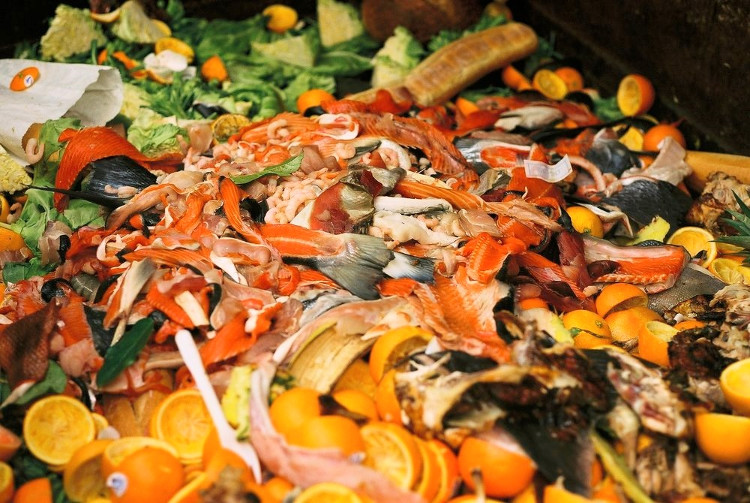Utilizing food waste - a new mission of biotechnology
Having achieved great achievements in increasing the efficiency of the food and food production chain, the world biotechnology industry in recent years is aiming at a link behind this chain: Handling food waste to utilize it as a valuable resource.
1/3 of food becomes garbage
In the past few years, the problem of food waste has emerged as an important cause of resource losses, bad environmental impacts and inequality. According to the United Nations Food and Agriculture Organization (FAO), every year humans waste about 1.3 billion tons of food, equivalent to one third of the world's production.
A rapidly growing world population raises food demand, leading to an expansion of the processing industry and processing that generates large amounts of waste. This is an important component in the proportion of food waste.

Waste - resources are not fully utilized.(Photos: Pinterest).
With high nutrient content, food waste is easily decayed when accumulating in large quantities, becoming a breeding and gathering place for many kinds of disease-causing organisms. This causes serious problems that are not easily solved on the environment.
The development of national waste management, treatment and disposal strategies is still progressing slowly. Therefore, the treatment of food waste emerges as a matter of priority science.
Traditional material source
In 2010, a report published by the European Union (EU) estimated that nearly 90 million tons of food waste are emitted annually from processing stages of the processing industry worldwide. Food waste comes from many stages in the supply chain: Packaging and storage after production, production, wholesale, retail and consumption.
In the process of manufacturing, processing food, waste usually arises from the process of peeling, washing, boiling, cutting and from byproducts such as pulp. For all types of waste generated from food processing activities of animal origin, sanitation risks are often much larger. Therefore, most efforts are currently focused on handling this type of waste.
Fish, cattle and poultry are the largest sources of food waste in animal origin. This type of garbage has a very high protein content, so it cannot be disposed directly into the environment without being processed.

Plant waste comes from cereals, fruits and vegetables.
The largest source of animal waste comes from cattle slaughterhouses with unsold products for consumers such as organs and mucus. The dairy industry, as well as dairy products, also produces a lot of waste, most commonly whey from butter . They are still being used to produce protein extracts and saccharides.
Plant waste comes from cereals, fruits and vegetables. Currently waste from processing rice, noodles and corn remains the main sources of biofuel production, as it is a staple food in many countries. Rice production each year supplies 730 million tons of straw for cattle, enough to produce 205 billion liters of ethanol. Straw has a high content of cellulose and hemicellulose, which can easily be converted into ethanol through resolution.
The production of wheat with a total global production of 682 million tons in 2009 also created byproducts like rice husks - a good source of ethanol.
Strong increase in added value
The application of technology to create added value from food waste is a positive step to improve the picture of food use efficiency and environmental protection. Biorefinery is a new concept similar to petrochemical refining before.

Food waste is a very good input material for renewable energy production.
Accordingly, all components of raw materials are converted into commercially valuable products such as biofuels, enzymes, oils, nutritional support products.
Food waste is a good source of inputs for the production of renewable energy by ingredients rich in cellulose and lignin (except for animal-derived waste). Many recent studies have shown that making chemicals from biomass generates three times more profit than biofuel production.
In this context, if waste management policies and regulations focus on promoting the value of waste in the food industry and related technologies, we can expect many sudden New breaking in this area.
- Method to turn astronaut waste into food
- People are wasting food
- Food waste every year is enough to feed three continents
- NASA turns human excrement into food for astronauts
- Czech Republic tightens the mandatory classification of waste
- Fly species - 'savior' is useful to handle leftover foods
- Many new studies at biotechnology conferences
- The technology turns plastic waste into edible fungus
- Launch missiles with waste water
- Indonesia strengthens biotechnology applications
- Electric waste like global time bomb
- Household items made from food waste of Japanese designers
 Is the magnetic North Pole shift dangerous to humanity?
Is the magnetic North Pole shift dangerous to humanity? Washington legalizes the recycling of human bodies into fertilizer
Washington legalizes the recycling of human bodies into fertilizer Lightning stone - the mysterious guest
Lightning stone - the mysterious guest Stunned by the mysterious sunset, strange appearance
Stunned by the mysterious sunset, strange appearance